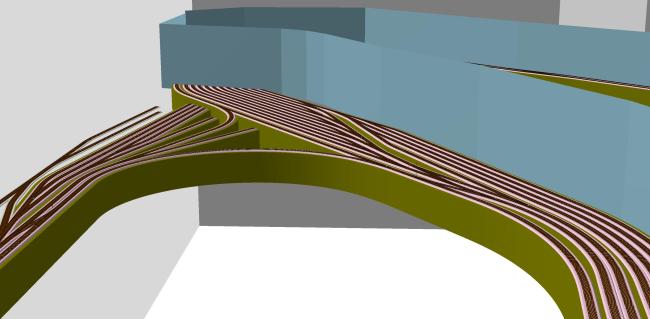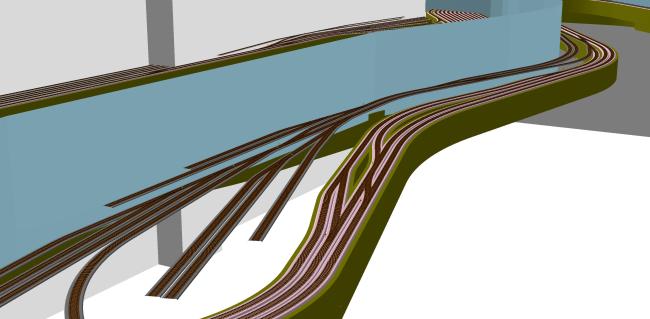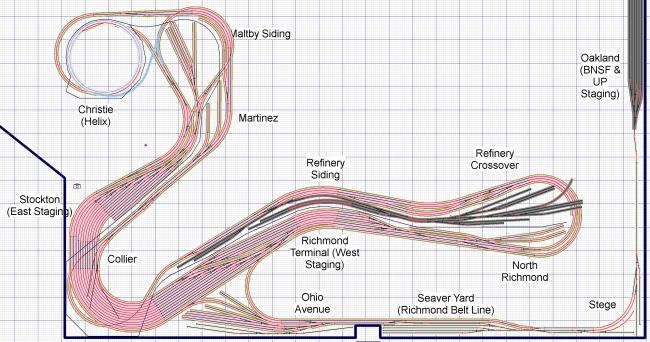The Basement Layout Plan
 Sunday, February 19, 2012 at 11:31AM
Sunday, February 19, 2012 at 11:31AM For the past few months, I have been working through the details of the plan for my new N scale layout.
Design Criteria
I have a number of important design criteria:
- Linear, walk around design
- 4-6 layout operators
- Crew space for relaxing between assignments
- Two decks okay
- Long mainline run
- Track plan supports multi-train mainline operation and shortline operation (a la Richmond Pacific)
- Emphasis on broad curves, long turnouts and long spurs
- Mainline and switching emphasized over expansive scenery and buildings
- Staging for 12 - 24 trains
- Typical train 3 units, 30 cars
- Continuous running option
- Phased construction
- Lightweight, modular construction
- Free-standing construction, minimal wall fixtures
Stockton Sub in N Scale
Where I’ve ended up, is a two deck plan that can be operated initally as a single deck layout and then extended as a multi deck layout if I find I am making good progress. It is loosely based on the BNSF Stockton Sub between Oakland/Richmond and Fresno California. Here’s the lower deck, the grid is on 1 foot centers (click on the image for a larger view):
The layout fits into the L-space between the TV/crew area (red brown color) and the basement walls as follows:

The plan maximizes the linear distance along the deck to maximize teh sense of distance.
Mainline Tour
A typical run would go between Oakland staging and Stockton staging. An Oakland train would begin it’s run by heading along the UP tracks to Stege. This is section of the layout is all bare staging, no scenery. The track between Oakland staging and Stege is in front of the door to the backyard and will have to be easily removable. At Stege, the tracks swing around one leg of the simulated wye onto Richmond Belt Line rails. This is my limited inclusion of the Richmond Pacific, but it nicely captures the movement of mainline freights over the shortline. Interchange operation is much more limited by this plan but not everything can be included.
The Richmond Belt Line continues past Seaver Yard to Ohio Avenue. The Richmond Beltline basically runs along the wall and there are several spurs which will represent industries on the Richmond Pacific. Operators on the Belt Line will be facing away from the main layout, so they should get the feel of operating a smaller shortline operation. Similar to the Richmond Pacific operations to North Richmond along the UP, the Richmond Belt Line will have trackage rights east to Refinery on the BNSF.
This is a rendering of the Richmond Terminal near the Ohio Ave Wye (click to expand).
 Richmond Terminal and Ohio Ave Wye
Richmond Terminal and Ohio Ave Wye
At Ohio Ave on the Richmond Belt Line, there is a wye connecting to the Richmond Terminal and the BNSF locomotive service area. The belt line has a Cemex plant and a couple of other industries to switch here as well. The Ohio Ave wye connects to the BNSF mainline that runs on the aisle side of the lower deck. The wye can be used to turn rolling stock or to turn entire trains on the western end between sessions.
Richmond Terminal is the western-most end of the BNSF Stockton Sub. The Terminal on the plan is a combination of west end staging and a small (4 track) classification yard, similar to the prototype Richmond Terminal. There are also a handful of rail-served industries at North Richmond that will be switched by the Richmond Belt Line.
UP Trackage Rights
To make operations interesting, UP trains will have trackage rights ove the BNSF Stockton Sub as far as Stockton. This means that BNSF and UP trains can travel over the modeled main line with westbound BNSF trains terminating at Richmond and Oakland (as the prototype does today) and UP westbounds terminating in Oakland. On the upper deck of the layout there will be a junction where UP trains return to home rails. In the first phase, however, where only the lower deck is in place, all eastbound trains will tie up in Stockton without any diverging from BNSF track.
East/West Staging
There is a 11-track dual ended staging yard that connects Richmond and Stockton. This facilitates easy re-staging of trains between sessions. As can be seen on the rendering of Richmond Terminal above, the ends of staging are visually separated from each other. The loop of main track at Collier is above the staging tracks and the double sided backdrop extends all the way across the staging tracks to the wall.
The main track beside staging connects Richmond and Stockton along the wall-side of staging to allow continuous running. Looking at Richmond Staging, the outer (large radius) track is the main, then there are three Arrival/Departure tracks, and the rest are staging tracks. The west end of the classification yard can be seen against the backdrop. During operating session Richmond will only send and receive westbound trains to and from the modeled portion of the layout. Stockton will do the opposite. At Richmond, where there is a yard crew and classification yard, trains will be broken down and assembled. At Stockton, there will be a single staging operator (mole) whose job it will be to operate the correct train to/from the correct staging track.
Continuing east (left along the aisle) from Richmond Terminal, the line runs to North Richmond. At North Richmond there are a few industries for the Richmond Belt Line to switch. North Richmond also marks the east end of Richmond Terminal. To the east, the main swings around the end of the peninsula and the switching lead parallels it around to the refinery complex on the other side of the peninsula.
 North Richmond and Richmond Terminal AisleRefinery
North Richmond and Richmond Terminal AisleRefinery
Around the end of the Peninsula is Refinery. This is a amalgam of refinerey operations at Crocket and Martinez California. There is lots of room at this location of the layout for tank car loading and marshalling areas. There is also a couple of interchange tracks for exchanging cars between both the Richmond Belt Line and the BNSF (UP does not have haulage rights on thiss BNSF line, only trackage rights). In-plant switching for the refinery will be handled by a refinery swiching operation akin to the WRSI in Richmond that serves Chevron. I’ve dubbed this location Refinery rather than the next logical station name which would be Rheem. I did not have room for Rheem and since it has no refinery operations on the prototype, I think I would find it distracting.
Refinery has a siding that can hold a typical 3-unit 30-car train comfortably.
 Refinery, looking eastMore to come. Post a comment below to let me know how you like the plan so far.
Refinery, looking eastMore to come. Post a comment below to let me know how you like the plan so far.
Coxy



Reader Comments (1)
That is a nice layout plan. I like the 3D graphics. Are you using rail cad or 3Dplanit?
Since this post was from February, how did it turn out?
I will be building the N scale Scenic Ridge kit (I tried my own freestyle railroad and decided to take a step back and try the kit)
Hope all goes well.
If you have a moment, please check out my blog--it's on many different hobbies, but hopefully it will give you a chuckle.
jackofallhobby.blogspot.ca